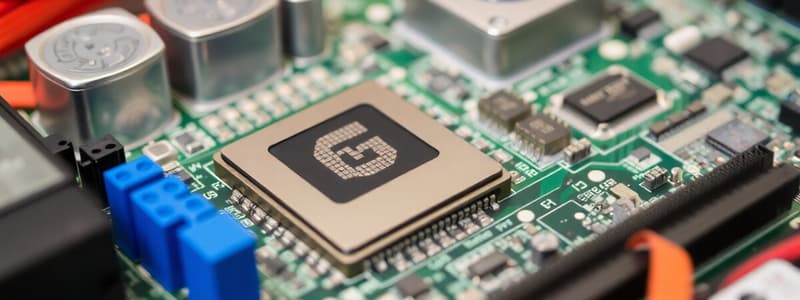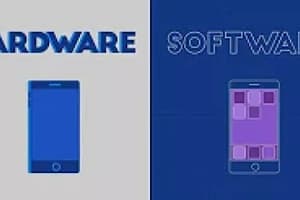Podcast
Questions and Answers
What are the three main parts of a computer system?
What are the three main parts of a computer system?
- Hardware, Software, Operating System
- Hardware, Software, Peripheral Devices
- Hardware, Software, User Interface
- Hardware, Software, Communication System (correct)
Which of the following is an example of hardware?
Which of the following is an example of hardware?
- Word processing software
- Web browser
- Spreadsheet application
- Monitor (correct)
What is the function of the Central Processing Unit (CPU)?
What is the function of the Central Processing Unit (CPU)?
- Store software applications
- Connect computers via communication media
- Display graphical data
- Perform all types of data processing operations (correct)
Which component is known as the heart of the computer?
Which component is known as the heart of the computer?
What does a Graphics Processing Unit (GPU) primarily handle?
What does a Graphics Processing Unit (GPU) primarily handle?
What does an Accelerated Processing Unit (APU) combine?
What does an Accelerated Processing Unit (APU) combine?
What primarily defines a communication system?
What primarily defines a communication system?
Which computer type is recognized to perform more than one trillion calculations per second?
Which computer type is recognized to perform more than one trillion calculations per second?
Which type of computer is typically used in large organizations to support thousands of users?
Which type of computer is typically used in large organizations to support thousands of users?
What is a typical application for microcomputers?
What is a typical application for microcomputers?
In which decade did minicomputers first become available?
In which decade did minicomputers first become available?
Which characteristic best describes supercomputers?
Which characteristic best describes supercomputers?
What is the primary difference between general-purpose and special-purpose computers?
What is the primary difference between general-purpose and special-purpose computers?
What type of computer was widely used for data collection and business transaction processing?
What type of computer was widely used for data collection and business transaction processing?
What is a defining feature of microcomputers compared to mainframe and minicomputers?
What is a defining feature of microcomputers compared to mainframe and minicomputers?
Which of the following is an example of a general-purpose computer?
Which of the following is an example of a general-purpose computer?
Which of the following describes an analog computer?
Which of the following describes an analog computer?
Which computer type is primarily used to perform arithmetic operations and logical calculations?
Which computer type is primarily used to perform arithmetic operations and logical calculations?
What is a common application of special-purpose computers?
What is a common application of special-purpose computers?
What type of data do analog computers primarily work with?
What type of data do analog computers primarily work with?
Which of the following is NOT a physical unit measured by analog computers?
Which of the following is NOT a physical unit measured by analog computers?
What is one of the main functions of an analog computer?
What is one of the main functions of an analog computer?
Flashcards are hidden until you start studying
Study Notes
Computer System Components
- A computer system is composed of three main parts: hardware, software, and a communication system (network).
- Hardware refers to the physical components of a computer system, such as the monitor, hard drive, keyboard, mouse, and printer.
- Software comprises programs and applications that provide instructions to the computer on how to process data.
- A collection of computers and devices connected through communication media forms a communication system or network.
Motherboard
- The motherboard serves as the central printed circuit board (PCB) that connects all components of a computer.
- It is known as the "heart" of the computer.
Processors
- The Central Processing Unit (CPU) executes all data processing operations.
- The Graphics Processing Unit (GPU) specializes in tasks like displaying 3D images and data encryption. GPUs are commonly found in gaming computers for their ability to process virtual environments efficiently.
- The Accelerated Processing Unit (APU) combines both the CPU and GPU into a single component.
Computer System Components
- The three main parts of a computer system are hardware, software, and data.
- Hardware refers to the physical components of a computer, including the monitor, keyboard, mouse, and internal components such as the CPU.
- Software consists of instructions that tell the hardware how to function.
- Data refers to the information that a computer processes and stores.
Computer Hardware
- The Central Processing Unit (CPU) is considered the "brain" or heart of a computer.
- The CPU's function is to execute instructions from software, performing calculations and processing data.
- A Graphics Processing Unit (GPU) primarily handles graphics rendering and other visual tasks.
- An Accelerated Processing Unit (APU) combines the functions of a CPU and a GPU into a single chip.
Communication Systems
- A communication system is defined by the interconnection of devices for the purpose of exchanging information.
- Communication networks are made up of various components such as devices, media, protocols, and users.
- Communications media, like wires, cables, and wireless signals, transmit information between devices in a communication network.
- Interconnection of devices is significant because it enables the flow of information between them.
- Successful communication systems require reliable transmission of data.
Computer Classification
- Computers are classified into three main categories based on their size, capacity, purpose, and hardware design.
Based on Size and Capacity
- Supercomputers are the fastest, most powerful, and most expensive computers.
- Used for complex mathematical calculations in research, weapons design, flight simulations, and other demanding fields.
- Capable of trillions of calculations per second.
- Mainframe Computers are very powerful and expensive computers that can support thousands of users simultaneously.
- Often used in large organizations, such as banks, companies, and research institutions.
- Users access resources via terminals or other devices connected to the mainframe.
- Minicomputers were introduced in the 1960s and handle more input/output than personal computers.
- Capable of managing hundreds of users at once.
- Widely used for scientific and engineering computations, business transactions, file management, and database management.
- Microcomputers are small, relatively inexpensive computers with a microprocessor as their central processing unit (CPU).
- Became popular in the 1970s and 1980s due to advancements in microprocessor technology.
- Widely used in various fields, including home, office, data collection, business, education, entertainment, publishing, and more.
- Examples include desktops, tablets, smartphones, and laptops.
Based on Purpose
- General Purpose Computers are designed to perform a wide range of tasks and can be programmed for various applications.
- Special Purpose Computers are designed for specific tasks and are not easily reprogrammed.
Based on Hardware Design
- Analog Computers operate on continuous data signals, representing information as physical quantities like voltage or current.
- Digital Computers operate on discrete data signals, representing information as binary digits (0s and 1s).
General Purpose Computers
- General purpose computers are designed to perform a variety of everyday tasks.
- They are typically smaller in size, have less storage capacity, and are more affordable compared to special purpose computers.
- General purpose computers have limited ability in performing specialized tasks.
- They are versatile and useful in serving basic needs at home or in the workplace.
- Examples of general purpose computers include:
- Desktops
- Laptops
- Smartphones
- Tablets
Special Purpose Computers
- Special purpose computers are designed to perform a specific or specialized task.
- The size, storage capacity, and cost of these computers depend on the nature and size of the work they are designed for.
- They have a consistent function and are specifically tailored to the particular task.
- Special purpose computers require specific processors, input, and output devices to efficiently conduct their tasks.
- Examples of special purpose computers include:
- Automatic Teller Machines (ATM)
- Washing Machines
- Surveillance equipment
- Traffic-control computers
Analog Computers
- Analog computers process data using continuous physical quantities that change continuously.
- They are primarily used to measure physical units such as voltage, pressure, electric current, and temperature and convert them into digits.
- Examples of analog computers include:
- Simple clocks
- Vehicle speedometers
- Voltmeters
Digital Computers
- Digital computers calculate and process data using numbers.
- They can perform basic arithmetic operations like addition, subtraction, multiplication, and division, as well as logical (mathematical) operations.
- A desktop or laptop computer is a common example of a digital computer.
Analog Computers
- Analog computers utilize continuous data, representing quantities that change smoothly, rather than discrete values.
- Analog computers excel at measuring physical units like voltage, pressure, electric current, and temperature, translating them into numerical representations.
Studying That Suits You
Use AI to generate personalized quizzes and flashcards to suit your learning preferences.



